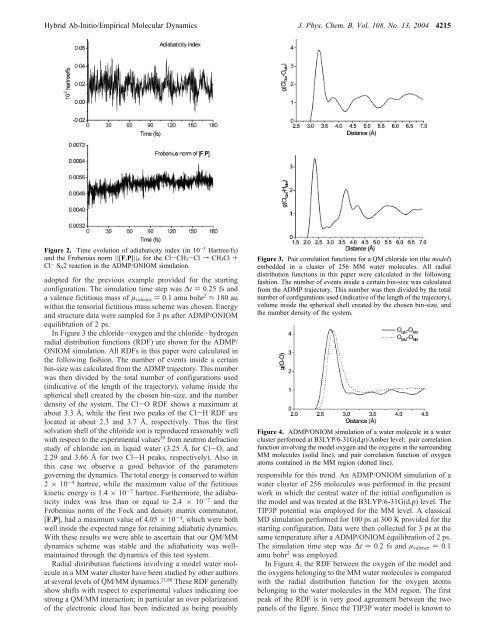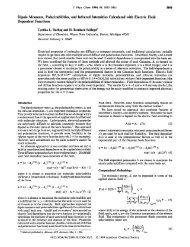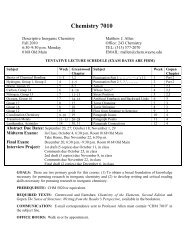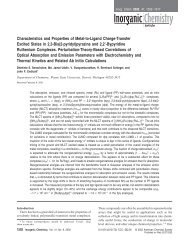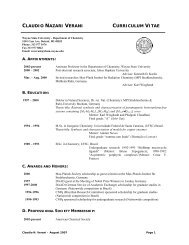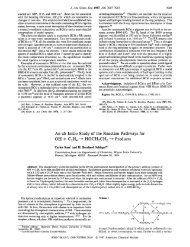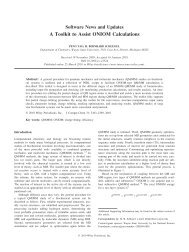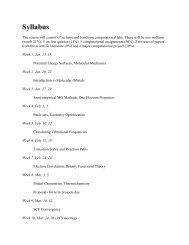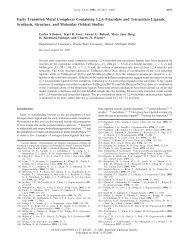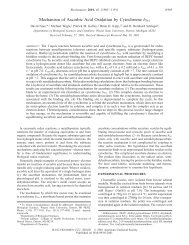Hybrid Ab-Initio/Empirical Molecular Dynamics - Wayne State ...
Hybrid Ab-Initio/Empirical Molecular Dynamics - Wayne State ...
Hybrid Ab-Initio/Empirical Molecular Dynamics - Wayne State ...
You also want an ePaper? Increase the reach of your titles
YUMPU automatically turns print PDFs into web optimized ePapers that Google loves.
<strong>Hybrid</strong> <strong>Ab</strong>-<strong>Initio</strong>/<strong>Empirical</strong> <strong>Molecular</strong> <strong>Dynamics</strong> J. Phys. Chem. B, Vol. 108, No. 13, 2004 4215Figure 2. Time evolution of adiabaticity index (in 10 -3 Hartree/fs)and the Frobenius norm ||[F,P]|| F for the Cl-CH 3-Cl f CH 3Cl +Cl - S N2 reaction in the ADMP/ONIOM simulation.adopted for the previous example provided for the startingconfiguration. The simulation time step was ∆t ) 0.25 fs anda valence fictitious mass of µ valence ) 0.1 amu bohr 2 ≈ 180 auwithin the tensorial fictitious mass scheme was chosen. Energyand structure data were sampled for 3 ps after ADMP/ONIOMequilibration of 2 ps.In Figure 3 the chloride-oxygen and the chloride-hydrogenradial distribution functions (RDF) are shown for the ADMP/ONIOM simulation. All RDFs in this paper were calculated inthe following fashion. The number of events inside a certainbin-size was calculated from the ADMP trajectory. This numberwas then divided by the total number of configurations used(indicative of the length of the trajectory), volume inside thespherical shell created by the chosen bin-size, and the numberdensity of the system. The Cl-O RDF shows a maximum atabout 3.3 Å, while the first two peaks of the Cl-H RDF arelocated at about 2.3 and 3.7 Å, respectively. Thus the firstsolvation shell of the chloride ion is reproduced reasonably wellwith respect to the experimental values 59 from neutron defractionstudy of chloride ion in liquid water (3.25 Å for Cl-O, and2.29 and 3.66 Å for two Cl-H peaks, respectively). Also inthis case we observe a good behavior of the parametersgoverning the dynamics. The total energy is conserved to within2 × 10 -4 hartree, while the maximum value of the fictitiouskinetic energy is 1.4 × 10 -7 hartree. Furthermore, the adiabaticityindex was less than or equal to 2.4 × 10 -7 and theFrobenius norm of the Fock and density matrix commutator,[F,P], had a maximum value of 4.05 × 10 -4 , which were bothwell inside the expected range for retaining adiabatic dynamics.With these results we were able to ascertain that our QM/MMdynamics scheme was stable and the adiabaticity was wellmaintainedthrough the dynamics of this test system.Radial distribution functions involving a model water moleculein a MM water cluster have been studied by other authorsat several levels of QM/MM dynamics. 21,60 These RDF generallyshow shifts with respect to experimental values indicating toostrong a QM/MM interaction; in particular an over polarizationof the electronic cloud has been indicated as being possiblyFigure 3. Pair correlation functions for a QM chloride ion (the model)embedded in a cluster of 256 MM water molecules. All radialdistribution functions in this paper were calculated in the followingfashion. The number of events inside a certain bin-size was calculatedfrom the ADMP trajectory. This number was then divided by the totalnumber of configurations used (indicative of the length of the trajectory),volume inside the spherical shell created by the chosen bin-size, andthe number density of the system.Figure 4. ADMP/ONIOM simulation of a water molecule in a watercluster performed at B3LYP/6-31G(d,p)/Amber level: pair correlationfunction involving the model oxygen and the oxygens in the surroundingMM molecules (solid line), and pair correlation function of oxygenatoms contained in the MM region (dotted line).responsible for this trend. An ADMP/ONIOM simulation of awater cluster of 256 molecules was performed in the presentwork in which the central water of the initial configuration isthe model and was treated at the B3LYP/6-31G(d,p) level. TheTIP3P potential was employed for the MM level. A classicalMD simulation performed for 100 ps at 300 K provided for thestarting configuration. Data were then collected for 3 ps at thesame temperature after a ADMP/ONIOM equilibration of 2 ps.The simulation time step was ∆t ) 0.2 fs and µ valence ) 0.1amu bohr 2 was employed.In Figure 4, the RDF between the oxygen of the model andthe oxygens belonging to the MM water molecules is comparedwith the radial distribution function for the oxygen atomsbelonging to the water molecules in the MM region. The firstpeak of the RDF is in very good agreement between the twopanels of the figure. Since the TIP3P water model is known to


